

A Feminist Approach to Jane Eyre. A Feminist approach to Jane Eyre.
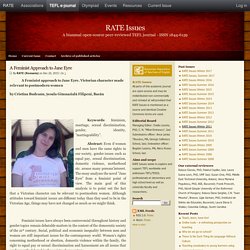
Victorian character made relevant to postmodern women by Cristina Budeanu, Școala Gimnazială Filipeni, Bacău Keywords: feminism, marriage, sexual discrimination, gender, identity, ”marriageability”. Abstract: Even if women and men have the same rights in our society, gender issues such as equal pay, sexual discrimination, domestic violence, motherhood etc. arouse many persons’interest. The essay analyzes the novel ”Jane Eyre” from a feminist point of view. Feminist issues have always been controversial throughout history and gender topics remain debatable matters in the context of the democratic society of the 21st century. The word "feminist" is defined as one which advocates equal rights for women. The aim of this essay is to answer two major questions: can we analyze the novel “Jane Eyre” from a feminist perspective? Taking into account all these arguments, it is evident that “Jane Eyre” can be analyzed from a feminist perspective.
Bibliography: < >. < < < Thesis final. 1) First Wave Feminism (1848 -1920) (dec of sentiments - right to vote) Flashcards. First-wave feminism. First-wave feminism refers to a period of feminist activity during the 19th and early 20th century throughout the world, particularly in the United Kingdom, Canada, the Netherlands and the United States.
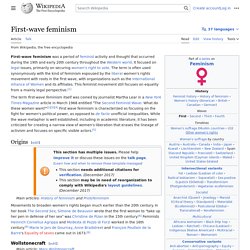
It focused on legal issues, primarily on gaining women's suffrage (the right to vote). The term first-wave was coined in March 1968 by Marsha Lear writing in The New York Times Magazine, who at the same time also used the term "second-wave feminism".[1][2] At that time, the women's movement was focused on de facto (unofficial) inequalities, which it wished to distinguish from the objectives of the earlier feminists. Origins[edit] According to Miriam Schneir, Simone de Beauvoir wrote that the first woman to "take up her pen in defense of her sex" was Christine de Pizan in the 15th century.[3] Heinrich Cornelius Agrippa and Modesta di Pozzo di Forzi worked in the 16th century.[3] Marie Le Jars de Gournay, Anne Bradstreet and François Poullain de la Barre wrote in the 17th.[3] Australia[edit]
The Women’s Rights Movement, 1848-1920. The fight for women’s suffrage in the United States began with the women’s rights movement in the mid-nineteenth century.
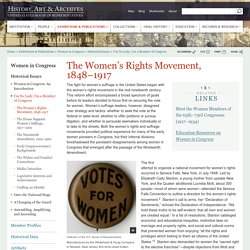
This reform effort encompassed a broad spectrum of goals before its leaders decided to focus first on securing the vote for women. Women’s suffrage leaders, however, disagreed over strategy and tactics: whether to seek the vote at the federal or state level, whether to offer petitions or pursue litigation, and whether to persuade lawmakers individually or to take to the streets. Women's Issues. Jane Eyre - Literature bibliographies. Where can I get a bibliography for the novel Jane Eyre by Charlotte Bronte? Charlotte Bronte's novel Jane Eyre which was first published in 1847 was a real shocker for the genteel novella-reading ladies who were wealthy enough to buy it to read.
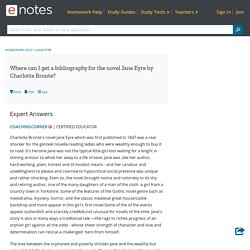
It's heroine Jane was not the typical little-girl-lost waiting for a knight in shining armour to whisk her away to a life of ease. Cours7 A3ALIT. Cours6 A3ALIT. Cours5 A3ALIT. Jane Eyre – In Our Time: Culture. Melvyn Bragg and guests discuss the life and work of Hans Holbein the Younger (1497-1543) during his two extended stays in England, when he worked at the Tudor Court and became the King's painter.

Holbein created some of the most significant portraits of his age, including an image of Henry VIII, looking straight at the viewer, hands on hips, that has dominated perceptions of him since. The original at Whitehall Palace was said to make visitors tremble at its majesty. Holbein was later sent to Europe to paint the women who might be Henry's fourth wife; his depiction of Anne of Cleves was enough to encourage Henry to marry her, a decision Henry quickly regretted and for which Thomas Cromwell, her supporter, was executed. InOurTime 20150618 JaneEyre. BeyondBelief 20180514 JaneEyre. Ffytche, "Psychology in Search of Psyches: Friedrich Schelling, Gotthilf Schubert and the Obscurities of the Romantic Soul" Woodman, "Romanticism, Alchemy, and Psychology" Late-Victorian Occultism. [Disponible en español] n her review essay of Alex Owen's Place of Enchantment, Dinah Birch admits that "with its secret societies, portentous mysticism, supposedly magical rites and invented traditions, occultism looks like self-indulgent posturing.
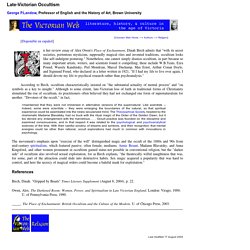
" Nonetheless, one cannot simply dismiss occultism, in part because so many important artists, writers, and scientists found it compelling; these include W.B.Yeats, Ezra Pound, Wassily Kandinsky, Piet Mondrian, Marcel Duchamp, Max Ernst, Arthur Conan Doyle, and Sigmund Freud, who declared in a letter written in 1921, "If I had my life to live over again, I should devote my life to psychical research rather than psychoanalysis. " According to Birch, occultism characteristically insisted on "the substantial actuality of mental process" and "on symbols as a key to insight. " >maintained that they were not immersed in alternative versions of the supernatural. References. Recent Studies of Victorian Psychology and its Relation to Victorian Literature. Peter Garratt, Victorian Empiricism: Self, Knowledge, and Reality in Ruskin, Bain, Lewes, Spencer, and George Eliot.

Madison, WI and Teaneck, NJ: Fairleigh Dickinson University Press, 2010. Gregory Tate, The Poet's Mind: The Psychology of Victorian Poetry 1830-1870. Oxford: Oxford University Press, 2012. Jean Rhys: Prostitution, alcoholism and the mad woman in the attic - Features - Books. The narrative of Jean Rhys's life – her "showgirl" career, her brief stint as a prostitute, her abortion paid for by an ex-lover, her three disastrous marriages, her alcoholism, her stay in Holloway prison for assault, her short sojourns in asylums – makes for unsettling reading.

She turned to men to prop her up and pay for her, and it is the kind of narrative we don't really want to read in a post-feminist age. Yet there's a fascinating truth at the heart of Jean Rhys, a truth that she herself often covered up. Born Ella Gwendolen Rees Williams on the island of Dominica in 1890, to a Welsh father and white Creole mother, she was, her latest biographer Lilian Pizzichini writes in her sympathetic but clear-eyed account, forever searching for a mother to love her.
Jean Rhys: Tossed about on an uneasy sea. Most writers aren't nearly as interesting as readers might imagine.
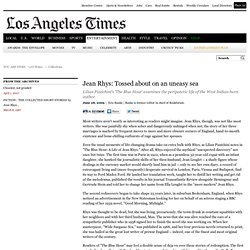
Jean Rhys, though, was not like most writers. She was painfully shy when sober and dangerously unhinged when not; the story of her three marriages is marked by frequent moves to more and more obscure corners of England, hand-to-mouth existence and bone-chilling outbursts of rage against her spouses. The Eyre Affair, Thursday Next. Texts to Compare to ‘Jane Eyre’ and ‘Wide Sargasso Sea’ Modernism, dreams and the supernatural » Wide Sargasso Sea Study Guide from Crossref-it.info. The significance of dreams Jean Rhys, like other twentieth century writers, made use of the ideas of Sigmund Freud concerning dreams as expressions of psychological states.
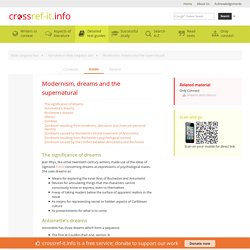
She uses dreams as: Means for exploring the inner lives of Rochester and Antoinette Devices for articulating things that the characters cannot consciously know or express, even to themselves A way of taking readers below the surface of apparent realism in the novel As means for representing secret or hidden aspects of Caribbean culture As presentiments for what is to come. Antoinette's dreams Antoinette has three dreams which form a sequence: The first at Coulibri (Part one, section 3) The second in the Mount Calvary convent (Part one, section 12) The third at Thornfield Hall (Part three, section 7).
As critics have noted, each is triggered by an event or situation that brings her closer to the final act of burning down Rochester's house. Dreams in Wide Sargasso Sea. We Deal In Dreams. Dreams in Wide Sargasso Sea Dreams are frequently used as a motif in literature. Why? In Jean Rhys’ Wide Sargasso Sea, dreams are so intricately intertwined with reality that the reader often has a hard time discerning which is which. Jean Rhys uses dreams to manifest Antoinette’s emotions she is unable to express in waking life. Space, place and landscape » Wide Sargasso Sea Study Guide from Crossref-it.info.
The significance of location Wide Sargasso Sea uses locations from Jean Rhys' childhood and family history. Both Coulibri and Granbois are based on estates owned by her family. This familiar landscape is very precisely defined in the novel. However, place and landscape are more than simply the setting for the action. Authorial Devices and the Importance of Setting in Rhys' "Wide Sargasso Sea" Although Wide Sargasso Sea presents itself as a distinctly modern rewriting of Jane Eyre, Jean Rhys clearly adopts more than a general plotline, or paradigm from her Victorian predecessor. Searching for identity and love: An analysis of ‘Wide Sargasso Sea’ Jean Rhys chooses Jamaica—known as the Wide Sargasso Sea—as the setting and climax of Antoinette and Rochester’s marriage.
Rhys also chooses Antoinette as the main protagonist in her novel. Opposing oppositional themes of passion and deception are the circumstantial plot customary in Jamaica. By utilizing scenic imagery, Rhys reinforces images of turbulent weather, chaos, and destruction the two bring into their marriage. The literary tone provides Rhys’ protagonist a chance to narrate her own story before she is renamed Bertha by Rochester in Charlotte Bronte’s novel Jane Eyre,—the maniac with no identity locked in the attic and given commands to “only make less noise” at the Thornfield estate—allowing neither Antoinette nor Rochester escapism. In utilizing literary themes of conflict that life entails, Rhys challenges us to embraces the inevitable destruction.
Across the Wide Sargasso Sea: Jean Rhyss Revision of Charlotte Brontës Eurocentric Gothic. Through the character of Christophine, Jean Rhys introduces the motif of witchcraft into the text. Realistically motivated by the West Indian context, witchcraft does not merely function as a picturesque inscription of native culture but as a metaphor of the relationship between language and power, and more specifically of the mechanisms by which the subaltern is silenced by master narratives.
Reading and Discussion Questions for Rhys' "Wide Sargasso Sea" The Experience of Womanhood in "Jane Eyre" and "Wide Sargasso Sea" Jane eyre LitChart. Character Map JE. Introduction » Jane Eyre Study Guide from Crossref-it.info. Jane Eyre Shared Experience Education Pack. Bronte Shared Experience Education Pack (2005) Jane Eyre Study Guide. Get literature in a whole new way with the LitCharts study guide to Charlotte Bronte's Jane Eyre.
Started by the guys who created SparkNotes back in the distant past, LitCharts are made for today’s students. Reader, it's Jane Eyre - Crash Course Literature 207. Bertha Mason: A 21st Century Woman Trapped in 1847. Patriarchal images of women who dominate Victorian literature typify the often debated binary oppositions — “madwoman in the attic” and “angel of the house”.
Contextualizing Racialized Interpretations of Bertha Mason's Character. Bertha Mason's Madness in a Contemporary Context. Public.wsu.edu/~delahoyd/eyre.doppelganger.html. Richard Juplit English 199 M. Charlotte Bronte's "Jane Eyre" Chapters 1-10 - Vocabulary List. Habituate familiarize psychologically or physically The action was more frank and fearless than any I was habituated to indulge in: somehow it pleased her. Charlotte Bronte's "Jane Eyre" Chapters 11-17 - Vocabulary List. "Jane Eyre," Vocabulary from Chapters 19-25 - Vocabulary List. "Jane Eyre," Vocabulary from Chapters 19-25 - Vocabulary List. "Jane Eyre," Vocabulary from Chapters 31-38 - Vocabulary List. The Red-Room and Jane's Imprisonment (1847) The red room. Charlotte Bronte: A Brief Biography. What is hell? - Jane Eyre. View on the window seat Jane Eyre. View on the window seat Jane Eyre.
Bertha Mason Article. Jane Eyre Critcal View Handout. Charlotte Brontë. Jane eyre teachers. Brocklehurst Chapter 4. Jane Eyre Red Room. History of Birds Jane Eyre. Jane Eyre Opening annotated. Jane Eyre Love and Marriage. Education in JE. Religion Jane Eyre. Syrie James Le journal secret de Charlotte Bronte. Gothic forms in Jane Eyre. The-victorians-regarded-charlotte-bront-as-coarse-and-immoral-and-deplored-jane-eyre-a6923616. Critic Reviews for Jane Eyre. Jane Eyre by Sarah Waters, Margaret Drabble, Jeanette Winterson and others.